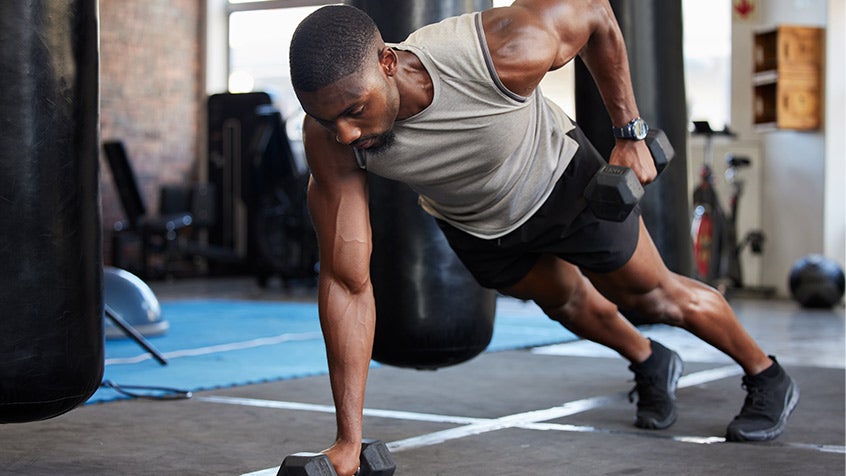Hypertrophy vs strength training
by Rob Flett on Thursday 11 January 2024
4 min read
Resistance training comes in many different forms. The two most common styles of resistance training are hypertrophy training and strength training. Hypertrophy relates to exposure to a training stimulus that increases muscle fibre size while strength training relates to exposure to a training stimulus that will increase the degree with which muscle fibres produce force. To put it simply... hypertrophy = bigger muscles and strength = stronger muscles.
Let’s explore the relationship between these two training styles and uncover key considerations.
Firstly, they are not mutually exclusive
Although strength and hypertrophy are two different training goals, they are essentially two sides of the same coin. Training to increase muscle size will cause you to become stronger as a by-product. Conversely, training to improve your strength will lead to increases in muscle size, particularly earlier on in your training journey. Where things start to diverge is when we want to maximise outcomes in one over the other. Ultimately this will come down to your training goal.
Reasons for specialising in one area
Typically, gym-goers will embark in hypertrophy training to grow muscles for aesthetic reasons, while others will strength train to improve their performance in specific exercises (e.g. deadlift 1 rep max).
If you’re unsure what style you want to adopt, below are some outcomes to be expected that might help decision making.
Hypertrophy -
- Improved body composition
- Increased work capacity
- Improved posture
- Muscular symmetry
- Improved metabolic health (e.g. insulin sensitivity)
Strength -
- Improved sport performance
- Injury prevention
- Ligament and tendon integrity
- Movement proficiency
- Body-wide stabilisation & control
Ultimately, these training adaptations will be determined by the training variables we are exposed to when resistance training.
Training variables
Hypertrophy and strength training are easily distinguishable by comparing the application of training variables.
Hypertrophy training involves maximising the volume with which we lift (reps x sets x load) over time while strength training involves maximising the intensity with which we lift (how much load we can put on the bar or machine). This means hypertrophy training requires us to lift light-moderate weight many times, over a wide variety of exercises. Alternatively, strength training requires us to lift heavy weights less frequently, across fewer exercises to maximise proficiency in each movement.
By example, let’s compare an upper body session.
If hypertrophy was the goal, we might complete 3 sets of 8-15 repetitions across exercises for the chest (e.g. a dumbbell bench press), back (e.g. a lat-pull down), shoulders (e.g. dumbbell lateral raises) and arms (e.g. dumbbell curls and cable pushdowns).
If strength was the goal, we might select our main movement as the bench press and complete 6 sets of 3 repetitions, followed by some assistance exercises at higher repetitions.
In a nutshell, the hypertrophy session spread a high volume of work across many muscle groups while the strength session targets a specific exercise (typically multi-joint) and allows for exposure to heavier loads.
Hypertrophy as a starting point…
It can be overwhelming knowing where to start in the weight-room.
If you’re in doubt, my advice would be to start with hypertrophy training. Putting on more muscle improves health markers, quality of life, longevity and sets a fantastic foundation for all sport and exercise. In relation to strength training, the bigger a muscle is the greater its force production potential. This means that even if you would like to go headfirst into strength training, spending some time on hypertrophy will improve the gains you reap later on. This approach also gives you time to become familiar with resistance training at light-moderate loads and prioritise quality of movement before chasing big weight numbers.
Lastly, a note for advanced gym-goers…
On the flip side, if you have been doing hypertrophy style training for a while and come across a training plateau, it might be beneficial to start venturing into the world of strength training. After teaching your muscles to produce more force, you’ll be able to use more load when going back to classical hypertrophy rep ranges, thereby sparking new-found muscle gains.
To sum up
Hypertrophy and strength training are very closely related and distinguishable by comparing specific training variables and the resulting adaptations. Hypertrophy sets a solid foundation and should be the starting point for most people beginning their weight-training journey. Although it is tempting to specialise in one, learning to incorporate aspects of the other within the context of a larger training plan will ultimately maximise results.
At Virgin Active, we offer an array of services to help you achieve your fitness goals. If you're looking for direction or wanting to take the next step on your fitness journey, reach out to learn more about our knowledgeable and specialised Personal Trainers. They will guide you through a plan that what works best for you and your preferred training style. See you on the gym floor!
About the author -
Related articles
Nourish
2 min read
Understanding nutrient density (and why it matters)
Move
3 min read
The ‘I don’t feel like working out’ plan
Unwind
3 min read
Can rest days make you stronger?
Enjoying our blog?
Sign up to our newsletter to get updates on training, healthy living, news and events.







